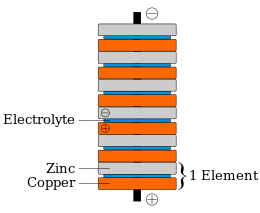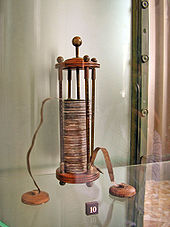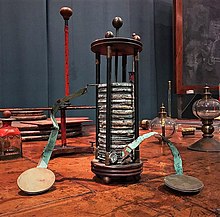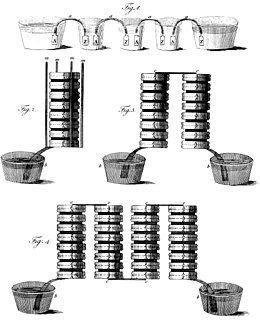Voltaic pile
This article includes a list ofgeneral references,butit lacks sufficient correspondinginline citations.(December 2010) |



Thevoltaic pilewas the firstelectrical batterythat could continuously provide an electric current to a circuit.[1]It was invented by Italian chemistAlessandro Volta,who published his experiments in 1799.[2]Its invention can be traced back to an argument between Volta andLuigi Galvani,Volta's fellow Italian scientist who had conducted experiments on frogs' legs.[3]Use of the voltaic pile enabled a rapid series of other discoveries, including the electrical decomposition (electrolysis) of water into oxygen and hydrogen byWilliam NicholsonandAnthony Carlisle(1800), and the discovery or isolation of the chemical elementssodium(1807),potassium(1807),calcium(1808),boron(1808),barium(1808),strontium(1808), andmagnesium(1808) byHumphry Davy.[4][5]
The entire 19th-century electrical industry was powered by batteries related to Volta's (e.g. theDaniell cellandGrove cell) until the advent of thedynamo(the electrical generator) in the 1870s.[6]
Volta's invention was built onLuigi Galvani's 1780s discovery that a circuit of two metals and a frog's leg can cause the frog's leg to respond.[1]Volta demonstrated in 1794 that when two metals andbrine-soaked cloth or cardboard are arranged in a circuit they too produce an electric current. In 1800, Volta stacked several pairs of alternatingcopper(orsilver) andzincdiscs (electrodes) separated by cloth or cardboard soaked in brine, which increased the total electromotive force.[7]When the top and bottom contacts were connected by a wire, an electriccurrentflowed through the voltaic pile and the connecting wire. The voltaic pile, together with many scientific instruments that belonged toAlessandro Volta,are preserved in theUniversity History Museum of the University of Pavia,where Volta taught from 1778 to 1819.[8]
History
[edit]The voltaic pile was created in 1800 by Alessandro Volta and was the first "true" battery, that gave off continuous charge.[3]
Applications
[edit]
On 20 March 1800,Alessandro Voltawrote to theLondonRoyal Societyto describe the technique for producing electric current using his device.[9]On learning of the voltaic pile,William NicholsonandAnthony Carlisleused it to discover theelectrolysisof water.Humphry Davyshowed that theelectromotive force,which drives the electric current through a circuit containing a single voltaic cell, was caused by a chemical reaction, not by the voltage difference between the two metals. He also used the voltaic pile to decompose chemicals and to produce new chemicals.William Hyde Wollastonshowed that electricity from voltaic piles had identical effects to those of electricity produced byfriction.In 1802Vasily Petrovused voltaic piles in the discovery and research ofelectric arceffects.
Humphry DavyandAndrew Crossewere among the first to develop large voltaic piles.[10]Davy used a 2000-pair pile made for theRoyal Institutionin 1808 to demonstrate carbonarc discharge[11]and isolate five new elements: barium, calcium, boron, strontium and magnesium.[12]
Electrochemistry
[edit]Because Volta believed that the electromotive force occurred at the contact between the two metals, Volta's piles had a different design than the modern design illustrated on this page. His piles had one extra disc of copper at the top, in contact with the zinc, and one extra disc of zinc at the bottom, in contact with the copper.[13]Expanding on Volta's work and the electro-magnetism work of his mentorHumphry Davy,Michael Faradayutilized both magnets and the voltaic pile in his experiments with electricity. Faraday believed that all "electricities" being studied at the time (voltaic, magnetic, thermal, and animal) were one and the same. His work to prove this theory led him to propose two laws of electrochemistry which stood in direct conflict with the current scientific beliefs of the day as laid down by Volta thirty years earlier.[14]Because of their contributions to the understanding of this field of study, Faraday and Volta are both considered to be among the fathers ofelectrochemistry.[15]The words "electrode" and "electrolyte", used above to describe Volta's work, are due to Faraday.[16]
Electromotive force
[edit]The strength of the pile is expressed in terms of itselectromotive force,or emf, given in volts. Alessandro Volta's theory ofcontact tensionconsidered that the emf, which drives the electric current through a circuit containing a voltaic cell, occurs at the contact between the two metals. Volta did not consider the electrolyte, which was typicallybrinein his experiments, to be significant. However, chemists soon realized that water in the electrolyte was involved in the pile's chemical reactions, and led to the evolution ofhydrogengas from the copper or silver electrode.[4][17][18][19]
The modern, atomistic understanding of a cell with zinc and copper electrodes separated by an electrolyte is the following. When the cell is providing an electrical current through an external circuit, the metallic zinc at the surface of the zinc anode is oxidized and dissolves into the electrolyte as electrically chargedions(Zn2+), leaving 2 negatively chargedelectrons(
e−
) behind in the metal:
- anode(oxidation): Zn → Zn2++ 2
e−
- anode(oxidation): Zn → Zn2++ 2
This reaction is calledoxidation.While zinc is entering the electrolyte, two positively chargedhydrogenions (H+) from the electrolyte accept two electrons at the copper cathode surface, become reduced and form an uncharged hydrogen molecule (H2):
- cathode(reduction): 2 H++ 2
e−
→ H2
- cathode(reduction): 2 H++ 2
This reaction is calledreduction.The electrons used from the copper to form the molecules of hydrogen are made up by an external wire or circuit that connects it to the zinc. The hydrogen molecules formed on the surface of the copper by the reduction reaction ultimately bubble away as hydrogen gas.
One will observe that the global electro-chemical reaction does not immediately involve the electrochemical couple Cu2+/Cu (Ox/Red) corresponding to the copper cathode. The copper metal disk thus only serves here as a "chemically inert" noble metallic conductor for the transport of electrons in the circuit and does not chemically participate in the reaction in the aqueous phase. Copper does act as a catalyst for the hydrogen-evolution reaction, which otherwise could occur equally well directly at the zinc electrode without current flow through the external circuit. The copper electrode could be replaced in the system by any sufficiently noble/inert and catalytically active metallic conductor (Ag, Pt, stainless steel, graphite,...). The global reaction can be written as follows:
- Zn + 2H+→ Zn2++ H2
This is usefully stylized by means of the electro-chemical chain notation:
- (anode: oxidation) Zn | Zn2+|| 2H+| H2| Cu (cathode: reduction)
in which a vertical bar each time represents an interface. The double vertical bar represents the interfaces corresponding to the electrolyte impregnating the porous cardboard disk.
When no current is drawn from the pile, each cell, consisting of zinc/electrolyte/copper, generates 0.76 V with a brine electrolyte. The voltages from the cells in the pile add, so the six cells in the diagram above generate 4.56 V of electromotive force.
Dry piles
[edit]A number of high-voltagedry pileswere invented between 1800 and the 1830s in an attempt to determine the source ofelectricityof the wet voltaic pile, and specifically to support Volta's hypothesis of contact tension. Indeed, Volta himself experimented with a pile whose cardboard discs had dried out, most likely accidentally.
The first to publish the discovery of a dry pile that produced a current wasJohann Wilhelm Ritterin 1802, albeit in an obscure journal; over the next decade, it was announced repeatedly as a new discovery. One form of dry pile is theZamboni pile.Francis Ronaldsin 1814 was one of the first to realize that dry piles also worked through chemical reaction rather than metal-to-metal contact, even though corrosion was not visible due to the very small currents generated.[20][21]
The dry pile could be referred to as the ancestor of the moderndry cell.[original research?]
See also
[edit]References
[edit]- ^ab"Battery: Voltaic Pile".americanhistory.si.edu.Retrieved2024-05-12.
- ^"Alessandro Volta | Biography, Facts, Battery, & Invention | Britannica".britannica.2024-04-15.Retrieved2024-05-12.
- ^ab"The Voltaic Pile | Distinctive Collections Spotlights".libraries.mit.edu.Retrieved2023-01-24.
- ^abDecker, Franco (January 2005)."Volta and the 'Pile'".Electrochemistry Encyclopedia.Case Western Reserve University. Archived fromthe originalon 2012-07-16.
- ^Russell, Colin (August 2003)."Enterprise and electrolysis..."Chemistry World.
- ^"Alessandro Volta | Biography, Facts, Battery, & Invention | Britannica".britannica.2024-04-15.Retrieved2024-05-12.
- ^Mottelay, Paul Fleury (2008).Bibliographical History of Electricity and Magnetism(Reprint of 1892 ed.). Read Books. p. 247.ISBN978-1-4437-2844-7.
- ^"Sala Volta".Musei Unipv.Retrieved21 August2022.
- ^Volta, Alessandro (1800)."On the Electricity Excited by the Mere Contact of Conducting Substances of Different Kinds".Philosophical Transactions of the Royal Society of London(in French).90:403–431.doi:10.1098/rstl.1800.0018.A partial translation of this paper is available online; see"Volta and the Battery".Retrieved2012-12-01.A complete translation was published inDibner, Bern (1964).Alessandro Volta and the Electric Battery.Franklin Watts. pp. 111–131.OCLC247967.
- ^Encyclopædia Britannica, 1911 edition, Volume V09, Page 185
- ^Tracking Down the Origin of Arc Plasma Science. II. Early Continuous Discharges
- ^Kenyon, T. K. (2008)."Science and Celebrity: Humphry Davy's Rising Star".Chemical Heritage Magazine.26(4): 30–35.Retrieved22 March2018.
- ^Cecchini, R.; Pelosi, G. (April 1992). "Alessandro Volta and his battery".IEEE Antennas and Propagation Magazine.34(2): 30–37.Bibcode:1992IAPM...34...30C.doi:10.1109/74.134307.S2CID6515671.
- ^James, Frank A. J. L. (1989)."Michael Faraday's first law of electrochemistry: how context develops new knowledge".In Stock, J. T.; Orna, M. V. (eds.).Electrochemistry, past and present.Washington, DC: American Chemical Society. pp. 32–49.ISBN9780841215726.
- ^Stock, John T. (1989). "Electrochemistry in retrospect: an overview". In Orna, Mary Virginia (ed.).Electrochemistry, past and present.Washington, DC: American Chemical Society. pp. 1–17.ISBN9780841215726.
- ^James, F.A.J.L. (18 July 2013). "The Royal Institution of Great Britain: 200 years of scientific discovery and communication".Interdisciplinary Science Reviews.24(3): 225–231.doi:10.1179/030801899678777.
- ^Turner, Edward (1841). Liebig, Justus; Gregory, William (eds.).Elements of chemistry: including the actual state and prevalent doctrines of the science(7 ed.). London: Taylor and Walton. p. 102.
During the action of a simple circle, as of zinc and copper, excited by dilute sulfuric acid, all of the hydrogen developed in the voltaic action is evolved at the surface of the copper.
- ^Goodisman, Jerry (2001)."Observations on Lemon Cells".Journal of Chemical Education.78(4): 516.Bibcode:2001JChEd..78..516G.doi:10.1021/ed078p516.Goodisman notes that many chemistry textbooks use an incorrect model for a cell with zinc and copper electrodes in an acidic electrolyte.
- ^Graham-Cumming, John (2009)."Tempio Voltiano".The Geek Atlas: 128 Places Where Science and Technology Come Alive.O'Reilly Media. p. 97.ISBN9780596523206.
- ^Ronalds, B.F. (2016).Sir Francis Ronalds: Father of the Electric Telegraph.London: Imperial College Press.ISBN978-1-78326-917-4.
- ^Ronalds, B.F. (July 2016). "Francis Ronalds (1788-1873): The First Electrical Engineer?".Proceedings of the IEEE.104(7): 1489–1498.doi:10.1109/JPROC.2016.2571358.S2CID20662894.
External links
[edit]- "Voltaic Pile Tutorial".National High Magnetic Field Laboratory.
- "The Voltaic Pile".Electricity. Kenyon.edu.
- Lewis, Nancy D., "Alesandro Volta The Voltaic Pile".
- Lewis, Nancy D., "Humphry Davy Electrochemistry".

